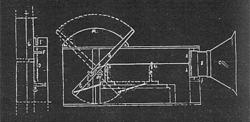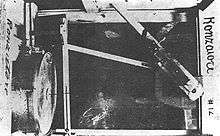Intonarumori

Intonarumori are a group of experimental musical instruments built and invented by the Italian futurist Luigi Russolo between roughly 1910 and 1930. There were 27 varieties of intonarumori in total with different names.
Background
Russolo built these instruments to perform the music outlined in his Art of Noises manifesto. The instruments were completely acoustic, not electronic. The boxes had various types of internal construction to create different types of noise. Often a wheel was touching a string attached to a drum. The wheel rattled or bowed the strings, while the drum functioned as an acoustic resonator. Many of the instruments featured a handle on top of the box, which was used to vary the string tension. Pulling the handle raised the tone, and the horn attached to the box amplified the sound. Intonarumori ('noise makers' in Italian) made noise, but not at a very loud volume, since they were all acoustic devices.
Intonarumori reconstruction


Most of Russolo's instruments were destroyed in Paris when that city was bombed during World War II. Others have simply disappeared.[1] Original sketches still exist, however, along with a few sound recordings of the original instruments. Based on these sources, three collections of reconstructions exist.
As part of its celebration of the 100th anniversary of Italian Futurism, the Performa 09 biennial, in collaboration with the Experimental Media and Performing Arts Center (EMPAC) and the San Francisco Museum of Modern Art, invited Luciano Chessa (author of the book Luigi Russolo, Futurist. Noise, Visual Arts, and the Occult) to direct a reconstruction project to produce accurate replicas of Russolo’s legendary Intonarumori instruments. This project offered the set of 16 original intonarumori (8 noise families of 1-3 instruments each, in various registers) that Russolo built in Milan in the summer of 1913. These intonarumori were physically built by luthier Keith Cary in Winters, California, under Chessa’s direction and scientific supervision. The concert premiered at San Francisco Museum of Modern Art on October 16, 2009, before traveling to New York City for its Performa 09 presentation at The Town Hall on November 12, 2009.[2] In September 2010 Chessa presented the recreated intonarumori in its first Italian appearance, a concert event at the Museum of Modern and Contemporary Art of Trento and Rovereto in Rovereto, Italy, as part of the Festival Transart, which featured performances by Nicholas Isherwood.[3]
With 2013 being the 100th anniversary of both The Art of Noises and John Cage’s birth, the curators of Carnegie Mellon University’s Wats:ON? Festival,[4] Golan Levin and Spike Wolff felt the time was ripe for a presentation of noise, and decided to reconstruct the forgotten Intonarumori instruments for the festival.[5] Carl Bajandas, a sculptor, an instrument builder, took the lead and built 10 Intonarumori instruments. Meanwhile, experimental composer, music technologist John Ozbay, has been asked to compose for the Intonarumori instruments.[6][7] The performance took place in Carnegie Mellon University's Kresge Theatre on April 4, 2013. Followed by performances of electronic/experimental music artists, Jeremy Boyle, Michael Johnsen, Eric Singer and Lesley Flanigan.[4][6][8]
Dutch sound artist Wessel Westerveld made a series of replicas. Westervelds replicas are the most professional versions with welded steel horns instead of cardboard and nailed steel cones like the Italian and NYC ones. The woodwork of these versions are also real hard wood instead of plywood. Westerveld has also made a few open variants with the sound system visible from the outside.[9] Westerveld performs regularly with his Intonarumori in collaboration with Dutch sound artist Yuri Landman. The Dutch replicas were shown and played by Westerveld at the Tuned City festivals in several cities, and a few times at the Gogbot Festival in Enschede. Lee Ranaldo wrote a score for the instruments at the Performa Festival in NYC.
References
- ↑ Barclay Brown, "The Noise Instruments of Luigi Russolo", Perspectives of New Music 20, nos. 1 & 2 (Fall-Winter 1981, Spring-Summer 1982): 31–48; citation on 36
- ↑ "Music for 16 Futurist Noise Intoners" http://turbulence.org/networked_music_review/2009/10/30/live-stagemusic-for-16-futurist-noise-intoners-nyc-ny/
- ↑ Intonarumori Das Orchester der Futuristischen Geräuscherzeuger
- 1 2 Wats:ON? Festival 2013
- ↑ Carnegie Mellon University - An Inspirational NOISE
- 1 2 Pittsburgh Post Gazette CMU's Wats:ON? Festival explores the origins of an abrasive genre
- ↑ John Ozbay, Intonarumori Concert Details
- ↑ Carnegie Mellon University - An Inspirational NOISE
- ↑ Intonarumori on the website of sound artist Wessel Westerveld
External links
- thereminvox.com about Intonarumori
- digicult.it about Intonarumori
- Russolo article on the website of Bart Hopkin
